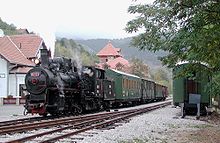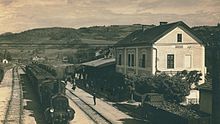Rail transport in Bosnia and Herzegovina
The rail in Bosnia and Herzegovina is operated by two railway companies of the Yugoslav railways have emerged (JŽ):
This dichotomy is based on the division of Bosnia and Herzegovina into two entities as a result of the Dayton Treaty . The coordination between the two companies is carried out by an umbrella company, Bosanskohercegovačka željeznička javna korporacija (BHŽJK).
The rolling stock of the ŽFBH and the ŽRS, especially in regional traffic, is poorly maintained in the passenger area. There are only a few connections, especially in the transfer stations in Sarajevo , Doboj and Banja Luka . Locomotives can be changed at the borders between the ŽFBH and the ŽRS without any technical necessity.
Route network
The length of the Bosnian-Herzegovinian rail network is currently 1026 kilometers. It used to be much more extensive, but around 1970 a number of narrow-gauge lines in Bosnian gauge were closed.
The two main railway axes in the country are:
- in south-north direction: (Ploče-) Čapljina-Mostar Konjic-Sarajevo in the valley of Neretva and on to Zenica-Doboj-Šamac in Bosna tal ( Pan-European Corridor No. Vc.)
- in west-east direction: ( Zagreb – Sunja–) Dobrljin – Banja Luka –Doboj –Tuzla - Zvornik (- Loznica )
In addition, the Belgrade – Bar line, with a stop in Štrpci, and the narrow-gauge Šarganska osmica museum railway each run over a short section across Bosnian-Herzegovinian territory.
The rail network is in poor condition. There are numerous speed restrictions and security systems that require a lot of staff.
Željeznice Federacije Bosne i Hercegovine (ŽFBH)
| Željeznice Federacije Bosne i Hercegovine
|
|
|---|---|
| legal form | Joint stock company owned by the Federation of Bosnia and Herzegovina |
| founding | 2001 |
| Seat |
Sarajevo , Bosnia and Herzegovina |
| Branch | transport |
| Website | www.zfbh.ba |
The Željeznice Federacije Bosne i Hercegovine (ŽFBH), German railways of the Federation of Bosnia and Herzegovina , have their headquarters in Sarajevo and operate the routes in the Federation of Bosnia and Herzegovina .
The ŽFBH emerged in 2001 from the merger of the Bosniak-controlled Željeznice Bosne i Hercegovine (ŽBH) and the Croatian-controlled Željeznice Herceg-Bosne (ŽHB). ŽBH / ŽFBH has been a member of the UIC since 1992 and uses the UIC country code 50.
The ŽFBH route network has the following scope:
| Multi-track | length |
|---|---|
| single track | 540 km |
| two-pronged | 68 km |
| Total | 608 km |
| electrified | length |
|---|---|
| with 25 kV 50 Hz | 441 km |
| Diesel operation | 167 km |
| Total | 608 km |
Freight transport
The railways play an important role in freight transport, especially in the country's industrial centers. In addition to the chemical companies, the main users and major customers in freight transport are the coal mining in Tuzla , the ironworks and ArcelorMittal in Zenica , the ore processing companies in Zenica and Tuzla and the aluminum works in Mostar .
The graph below shows the amount of goods transported in thousands of tons on the lines of the public railways of the Federation of Bosnia and Herzegovina.

passenger traffic
Within Bosnia and Herzegovina, the railroad is of little importance in passenger traffic today, most of the public transport is handled by coaches. The following connections exist in the Federation of Bosnia and Herzegovina:
- Sarajevo – Zenica: Five pairs of trains a day
- Sarajevo– Konjic : Three pairs of trains a day
- Express train connection Sarajevo – Konjic – Mostar– Čapljina : One pair of trains per day
There is also an express train connection from Sarajevo via Doboj and Banja Luka to Zagreb in Croatia . This is supplemented by a pair of express trains between Sarajevo and Doboj.
In July 2005 , the ŽFBH ordered nine nine-part Talgo sets, which are technically derived from the Talgo 7 , but cannot change lanes. Five units are set up as a day train with 237 seats and four units as a night train with 186 seats. After years of preparation, the Talgo trains have been running on schedule on the Sarajevo – Doboj route since 2016. Since June 2017, the Taglo trains have also been running between Sarajevo via Mostar and Čapljina. The planned connection from Doboj to Banja Luka or even to Zagreb did not come about up to this point.
Željeznice Republike Srpske (ŽRS)
| Željeznice Republike Srpske
|
|
|---|---|
| legal form | Joint stock company, 60% owned by the Republika Srpska |
| founding | 1992 |
| Seat |
Doboj , Bosnia and Herzegovina |
| Branch | transport |
| Website | www.zrs-rs.com |
The Željeznice Republike Srpske (ŽRS or Željeznice RS), German railways of the Republika Srpska , have their headquarters in Doboj and operate the routes in the Republika Srpska .
The ŽRS have been a member of UIC since 1998 and use the UIC country code 44.
The ŽRS route network has the following scope:
| Route length | electrified with 25 kV 50 Hz alternating current |
not electrified | Total |
|---|---|---|---|
| single track | 313.47 km | 80.22 km | 393.69 km |
| two-pronged | 24.60 km | - | 24.60 km |
| Total | 338.07 km | 80.22 km | 418.29 km |
passenger traffic
The following routes are operated in the Republika Srpska:
- Doboj– Šamac : One pair of trains a day
- Doboj– Petrovo Novo – Tuzla: three pairs of trains to Petro Novo, two pairs of trains continue to Tuzla, in the timetable these trains are referred to as identity trains (Medjuentitetski)
- Doboj – Banja Luka: Two pairs of trains a day
- Banja Luka - Novi Grad - Dobrljin : One train runs continuously from Banja Luka to Dobrljin, two more only to Novi Grad. There is also a morning train from Novi Grad to Dobrljin. In the opposite direction, two trains run continuously from Dobrljin to Banja Luka and another train from Novi Grad to Banja Luka.
history
Austro-Hungarian rule
Standard gauge
When the Austro-Hungarian army occupied the country in 1878 , they came across the remains of the railway from Dobrljin to Banja Luka, which was built under Ottoman rule . It was opened in 1872 by the Orientbahn as part of an Ottoman Sandschakbahn . The repair work was very complex, but in the spring of 1879 the 101.6 kilometer stretch was reopened as the " kuk military railway Banjaluka – Dobrlin ". In 1882 the gap between Dobrljin and Sisak (Croatia) was closed, creating the direct standard gauge line between Vienna and Banja Luka. The 4 km long connecting line Slavonski Brod - Bosanski Brod and the 1 km long end section of the local line Vinkovci - Brčko also crossed the border .
Narrow gauge
Most of the railway lines in Bosnia and Herzegovina were narrow-gauge in Bosnian gauge (760 mm) and were operated by the Bosnian-Herzegovinian State Railways (BHStB). The first stretch of the extensive narrow-gauge network was the Bosna Railway from Bosanski Brod to Zenica, which was built as a military taxiway and was soon extended to Sarajevo. At the time, it represented the region's first modern means of transport and was quickly adapted and expanded to meet the needs of civil transport. The main routes of BHStB were the some with rack sections provided Narentabahn of Sarajevo through Mostar to the Adriatic coast and the East Bosnian railway . In the course of the annexation of Bosnia and Herzegovina , the BHStB was renamed to Bosnian-Herzegovinian State Railways (BHLB) in 1908 .
Competitive thinking and ongoing disputes between Austria and Hungary prevented the development of an efficient standard gauge network. In 1912/13 during the Balkan Wars and especially at the beginning of the First World War, the limited capacity of the Bosnian-Herzegovinian rail network became apparent.
Narrow-gauge forest and industrial railways
The forest railways , which were used to transport the extensive logs from the vast forests, were of great importance in Bosnia . The expansion of the forest railway network temporarily exceeded the length of the public railways. The private Steinbeisbahn with its main route from Prijedor to Knin was tackled as a forest railway at the end of the 19th century. Later - especially in Yugoslav times - their fixed routes became an integral part of the public network. The main route of the Usora Valley Railway and Forest Railway Teslić from Doboj to Teslić was later also used by public transport. The Usora Valley Railway , like the Krivaja Forest Railway Zavidovići – Olovo – Kusače, was owned by the Land of ärars , but both were leased to private companies. There were also various other forest railways, each of which was set up for the duration of the timber harvesting contracts in the individual logging areas.
In the industrial and sidings which are mining train Vogošća-Čevljanovići-Ivančići for transportation of ores and timber and the normalspurige today siding Podlugovi-Vareš worth mentioning.
Yugoslavia

After the establishment of the Yugoslav state after the First World War, the Bosnian-Herzegovinian State Railways (BHLB) became part of the railways of the Kingdom of Serbs, Croats and Slovenes (SHS). In 1929 it became the Jugoslovenske Državne Železnice (JDŽ, Yugoslav State Railways) and in 1954 the Jugoslovenske Železnice (JŽ, Yugoslavian Railways). The narrow-gauge trains or their steam locomotives were affectionately called "Ćiro" in the Yugoslav vernacular.
Kingdom of Yugoslavia
The newly formed Yugoslav SHS state expanded the railway lines taken over from the predecessor states into a coherent network. In 1925, the Sargan Railway connected the Bosnian Eastern Railway with the Serbian rail network, creating a coherent narrow-gauge network. Continuous, narrow-gauge express trains, equipped with dining and couchette cars, traveled from Belgrade via Sarajevo to Dubrovnik with a journey time of 23 hours . A branch line of the Dalmatian Railway was extended from Trebinje to Nikšić in 1931/38 , from where, from 1948, the narrow-gauge line to Podgorica established the connection with the Montenegrin capital.
The Ugljevik - Bijeljina - Bosanska Rača line on today's Serbian border opened up the coal deposits in Ugljevik, which went into operation from 1922 to 1925 . In 1939 the line was extended to Bosanska Mezgraja. A new lines between Pazarić and Tarcin and a 1931 Opened prolonged Ivan tunnel enabled the shortening of the rack portion of Narentabahn . The network was supplemented by the construction of further branch lines. The Bosnian Eastern Railway was supplemented in 1929 with the branch line Uvac - Priboj and in 1939 with the wing line Ustiprača - Foča .
Socialist Republic of Yugoslavia
After the Second World War, the Yugoslav narrow-gauge railways were initially of great importance, but were no longer able to meet the needs of transport. Nevertheless, the Lašva – Donji Vakuf route over the Komar Pass was extended to Gornji Vakuf in 1945 and in 1947 with a wing route from Bila Nova to Trenica. Otherwise, the main lines of the narrow-gauge network were switched to standard gauge or new connections were built.
In 1948 the Una Railway was opened in the border area of Croatia and Bosnia-Herzegovina from Novi Grad to Knin. When it was built, the route of the Steinbeisbahn was converted to standard gauge on the Lička Kaldrma – Knin section.
As part of socialist youth work campaigns, additional standard-gauge railway lines were built. In 1946 around 60,000 young people from all over Yugoslavia built the 92-kilometer Brčko - Banovići railway line in just seven months . The main purpose of the route is to develop the coal deposits in Banovići. In 1947, 220,000 boys built the 242-kilometer Sarajevo – Šamac route with 17 bridges and nine tunnels. On the Sarajevo – Doboj section, the tracks of the Bosna Railway were converted to standard gauge, while the Doboj – Šamac section was rebuilt. The new construction of the 90 km long Doboj – Banja Luka railway line in 1951 with 34 bridges and three tunnels was one of the last great works of the youth work campaigns.
The narrow-gauge Narentabahn was largely re-routed from 1963 and converted to standard gauge. It was reopened in 1966 as the Sarajevo – Ploče railway line . The remaining narrow-gauge railways suffered more and more from competition from road traffic. Their operations ceased in the 1960s and 1970s, when trucks and buses took over.
Bosnia and Herzegovina
The proclamation of the Republic of Bosnia and Herzegovina and the Republika Srpska in 1992 and the Croatian Republic of Herceg-Bosna in 1993 led to the division of the railways into three companies:
- Željeznice Bosne i Hercegovine (Railways of Bosnia and Herzegovina) based in Sarajevo
- Srpske željeznice (Serbian Railways) based in Banja Luka
- Željeznice Herceg-Bosne (Herceg-Bosna Railways) based in Mostar
During the Bosnian War , the Bosnian-Herzegovinian railway network, like the rest of the infrastructure, was permanently damaged. 300 train stations, 18 bridges, including those over the Sava and Neretva , 140 locomotives, 6,700 passenger and freight cars, 190 kilometers of overhead contact lines and all of the safety and telecommunications systems were destroyed. When the Federal Republic of Bosnia and Herzegovina was established after the war in 1995 with the Dayton Treaty , the Srpske željeznice changed their name to Željeznice Republike Srpske (ŽRS) and in 1996 moved their headquarters from Banja Luka to Doboj. In 2001 the Željeznice Federacije Bosne i Hercegovine (ŽFBH) was created through the merger of the other two railway companies .
It took a long time to repair the war damage. By 1998, 700 kilometers of the original 1200-kilometer rail network could be made navigable again. Only since 2001 have express trains been running again between Zagreb and Sarajevo. A year later, operations across the border between Šamac and Slavonski Šamac in Croatia were resumed.

From 2006 to 2010, the Bosnian section from the border to Višegrad of the Serbian museum railway Šarganska osmica was reopened, but in 2011 it was hardly used commercially. Besides a short mining railway near Banovići, it is the only remnant of the formerly extensive Yugoslav narrow-gauge network in Bosnia and Herzegovina remaining in Bosnia and Herzegovina with a Bosnian gauge of 760 mm.
In 2010, the Croatian industrial company Končar Group delivered a prototype low-floor train to ŽFBH. From July 2012 the train ran between Zenica and Mostar as scheduled. After 8 months, the low-floor train had to be shut down due to damage and later returned to the manufacturer due to financial difficulties.
In 2011, the Novi Grad – Prijedor – Banja Luka – Doboj lines of the ŽRS and Sarajevo – Mostar – Čapljina of the ŽFBH were completely renovated. The subsequent Croatian section from Čapljina to Ploče had already been renewed. A pair of trains ran between Sarajevo and Ploče, but with the 2013/2014 timetable change, the Croatian Railways (HŽ) stopped passenger services on their section between Čapljina and Ploče.
The Talgo trains delivered to ŽFBH in 2005 were initially parked for five years until a pair of trains between Sarajevo and Doboj started operating in 2016. The modern trains have been running on the Sarajevo – Mostar – Čapljina route since 2017, and the Sarajevo – Doboj line to Banja Luka was extended in the same year.
swell
- Victor von Röll : Bosnian-Hercegovinian Railways. In: Encyclopedia of Railways. 1912, pp. 463–468 , accessed on October 1, 2016 (Volume 2. Berlin, Vienna).
- Elmar Oberegger : Excursus: Basics of the railway history of Bosnia-Herzegovina (1878–1914). Retrieved October 1, 2016 .
References and comments
- ↑ Zakon o Željeznicama Federacije Bosne i Hercegovine. Federal Railways Act of Bosnia and Herzegovina. Retrieved October 1, 2016 (Bosnian).
- ↑ Infrastructure - length of railway lines. In: website of the ŽFBH. Retrieved October 1, 2016 .
- ↑ First i obim prijevoza po godinama. (Types and scope of transport after years.) On the ŽFBH website. Retrieved October 1, 2016 (Bosnian).
- ↑ Timetable. 2015/16 timetable in PDF format. In: website of the ŽFBH. Retrieved October 1, 2016 (Bosnian).
- ↑ a b Talgo trains run on the Sarajevo - Čapljina route. In Eisenbahn-Revue International, 8–9 / 2017, p. 410
- ↑ Bosnian Talgo trains finally in use . In: Swiss Railway Review . No. 11 . Minirex, 2016, ISSN 1022-7113 , p. 545 .
- ↑ Bosnia: ŽFBiH uses Talgo trains. Eurailpress.de, September 28, 2016, accessed October 20, 2016 .
- ↑ Timetable. In: Website of the ŽRS. Retrieved October 1, 2016 (Serbian).
- ↑ Werner Schiendl : The railways in Bosnia and Herzegovina 1867 - 1918. Edition Bahn im Film, Vienna 2015, ISBN 978-3-9503096-5-2 , p. 30
- ↑ today Brod
- ↑ Pruga Bosanska Rača - Bijeljina - Ugljevik (–Bosanska Mezgraja) on the Serbian-speaking forum "Forum ljubitelja železnica"
- ↑ Istočna pruga Sarajevo-Ustiprača-Višegrad-Vardište on the Serbian-speaking forum "Forum ljubitelja železnica"
- ↑ Snežana Milošević: Vratiće se “Ćiro”… “Ćiro” returns… (No longer available online.) InfoBijeljina.com, June 30, 2015, archived from the original on October 22, 2016 ; Retrieved October 1, 2016 (Serbian). Info: The archive link was inserted automatically and has not yet been checked. Please check the original and archive link according to the instructions and then remove this notice.
- ↑ The extension from Foča to Miljevina was opened to traffic in 1962. (Keith Chester: The Narrow Gauge Railways of Bosnia-Hercegovina . Stenvalls, Malmö 2006, ISBN 91-7266-166-6 . )
- ↑ Srecko Mihailovic, Grujica Spasojevic: Tito na radnim akcija . Tito in a labor dispute. Ed .: Istraživačko-izdavački centar SSO Srbije. Belgrade 1979 (Serbian).
- ^ Slobodan Ristanović: TO SU NAŠIH RUKU DELA - Herojska i slavna epopeja omladinskih radnih akcija 1941–1990. On the work of our hands - the heroic and glorious epic of the youth work campaigns 1941–1990. Retrieved October 1, 2016 .
- ↑ a b Railways in Bosnia-Herzegovina. In: Swiss Railway Review . No. 4/1998. Minirex, ISSN 1022-7113 , p. 158.
- ↑ previously Bosanski Šamac
- ↑ Stiže novi elektromotorni niskopodni vlak iz Končara. Končar's new low-floor train has been completed. Metro portal, September 28, 2009, accessed October 1, 2016 (Croatian).
- ↑ Nova era poslovanja Željeznica FBiH! (PDF; 2.8 MB) A new era begins for the BIH railways! In: ŽFBH Info. Retrieved October 1, 2016 (Bosnian, May 24 / June 2012 edition).
- ↑ ŽFBH vraćaju niskopodni elektromotorni vlak Končaru zbog nedostatka novaca. ŽFBH return low-floor electric train to Končar due to lack of money. (No longer available online.) Zeljeznice.net, November 8, 2013, archived from the original on October 20, 2016 ; accessed on October 1, 2016 (Croatian). Info: The archive link was inserted automatically and has not yet been checked. Please check the original and archive link according to the instructions and then remove this notice.
- ^ Trains in Bosnia and Herzegovina. Interrail, accessed October 1, 2016 .
- ↑ Toma Bacic: Bosnian Talgo trains finally in use. In: Swiss Railway Review. No. 11/2016. Minirex, ISSN 1022-7113 , p. 545.
- ↑ Toma Bacic, Mathias Rellstab: Talgo trains run on the Sarajevo - Capljina line. In: Swiss Railway Review. No. 8–9 / 2017. Minirex, ISSN 1022-7113 , pp. 411-412.
- ^ Mathias Rellstab: Talgo to Banja Luka. In: Swiss Railway Review. No. 10/2017. Minirex, ISSN 1022-7113 , p. 513.













